HND Hospitality: Food Safety Management - A Comprehensive Report
VerifiedAdded on 2020/10/04
|13
|4018
|294
Report
AI Summary
This report provides a detailed overview of food safety management within the hospitality industry, focusing on Prezzo, an Italian restaurant in the UK. It addresses the critical aspects of preventing physical and chemical contamination of food, compares food poisoning and foodborne infections, and discusses methods to control foodborne illnesses. The report also categorizes food spoilage agents, examines food preservation methods and their effectiveness, and outlines key steps in a temperature control system for safe food storage. Furthermore, it emphasizes the importance of personal hygiene, cleaning, disinfection, pest control, hygienic design, and training as quality assurance mechanisms. The report concludes with a food hazard risk assessment and a discussion of food safety control systems for legislative compliance.
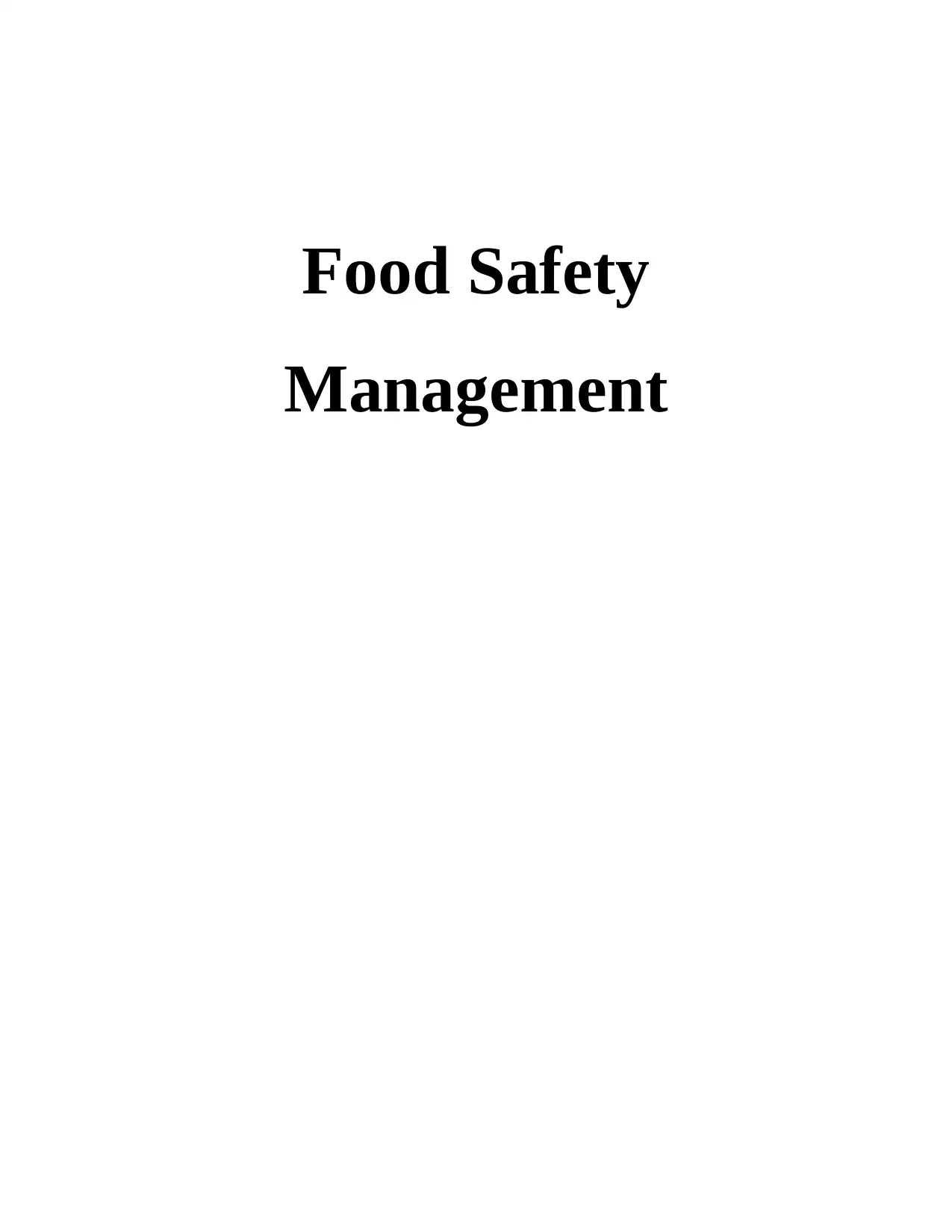
Food Safety
Management
Management
Paraphrase This Document
Need a fresh take? Get an instant paraphrase of this document with our AI Paraphraser
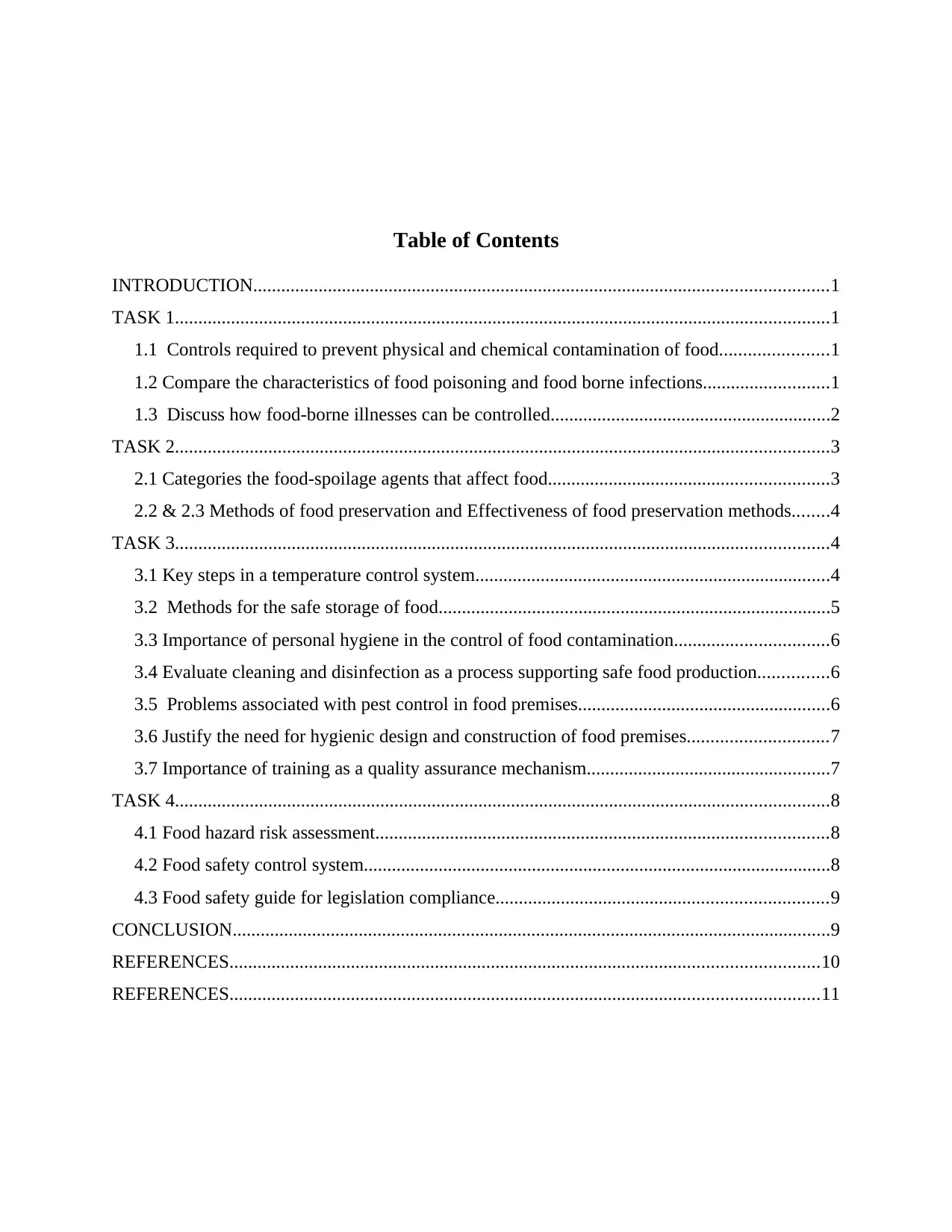
Table of Contents
INTRODUCTION...........................................................................................................................1
TASK 1............................................................................................................................................1
1.1 Controls required to prevent physical and chemical contamination of food.......................1
1.2 Compare the characteristics of food poisoning and food borne infections...........................1
1.3 Discuss how food-borne illnesses can be controlled............................................................2
TASK 2............................................................................................................................................3
2.1 Categories the food-spoilage agents that affect food............................................................3
2.2 & 2.3 Methods of food preservation and Effectiveness of food preservation methods........4
TASK 3............................................................................................................................................4
3.1 Key steps in a temperature control system............................................................................4
3.2 Methods for the safe storage of food....................................................................................5
3.3 Importance of personal hygiene in the control of food contamination.................................6
3.4 Evaluate cleaning and disinfection as a process supporting safe food production...............6
3.5 Problems associated with pest control in food premises......................................................6
3.6 Justify the need for hygienic design and construction of food premises..............................7
3.7 Importance of training as a quality assurance mechanism....................................................7
TASK 4............................................................................................................................................8
4.1 Food hazard risk assessment.................................................................................................8
4.2 Food safety control system....................................................................................................8
4.3 Food safety guide for legislation compliance.......................................................................9
CONCLUSION................................................................................................................................9
REFERENCES..............................................................................................................................10
REFERENCES..............................................................................................................................11
INTRODUCTION...........................................................................................................................1
TASK 1............................................................................................................................................1
1.1 Controls required to prevent physical and chemical contamination of food.......................1
1.2 Compare the characteristics of food poisoning and food borne infections...........................1
1.3 Discuss how food-borne illnesses can be controlled............................................................2
TASK 2............................................................................................................................................3
2.1 Categories the food-spoilage agents that affect food............................................................3
2.2 & 2.3 Methods of food preservation and Effectiveness of food preservation methods........4
TASK 3............................................................................................................................................4
3.1 Key steps in a temperature control system............................................................................4
3.2 Methods for the safe storage of food....................................................................................5
3.3 Importance of personal hygiene in the control of food contamination.................................6
3.4 Evaluate cleaning and disinfection as a process supporting safe food production...............6
3.5 Problems associated with pest control in food premises......................................................6
3.6 Justify the need for hygienic design and construction of food premises..............................7
3.7 Importance of training as a quality assurance mechanism....................................................7
TASK 4............................................................................................................................................8
4.1 Food hazard risk assessment.................................................................................................8
4.2 Food safety control system....................................................................................................8
4.3 Food safety guide for legislation compliance.......................................................................9
CONCLUSION................................................................................................................................9
REFERENCES..............................................................................................................................10
REFERENCES..............................................................................................................................11

⊘ This is a preview!⊘
Do you want full access?
Subscribe today to unlock all pages.

Trusted by 1+ million students worldwide
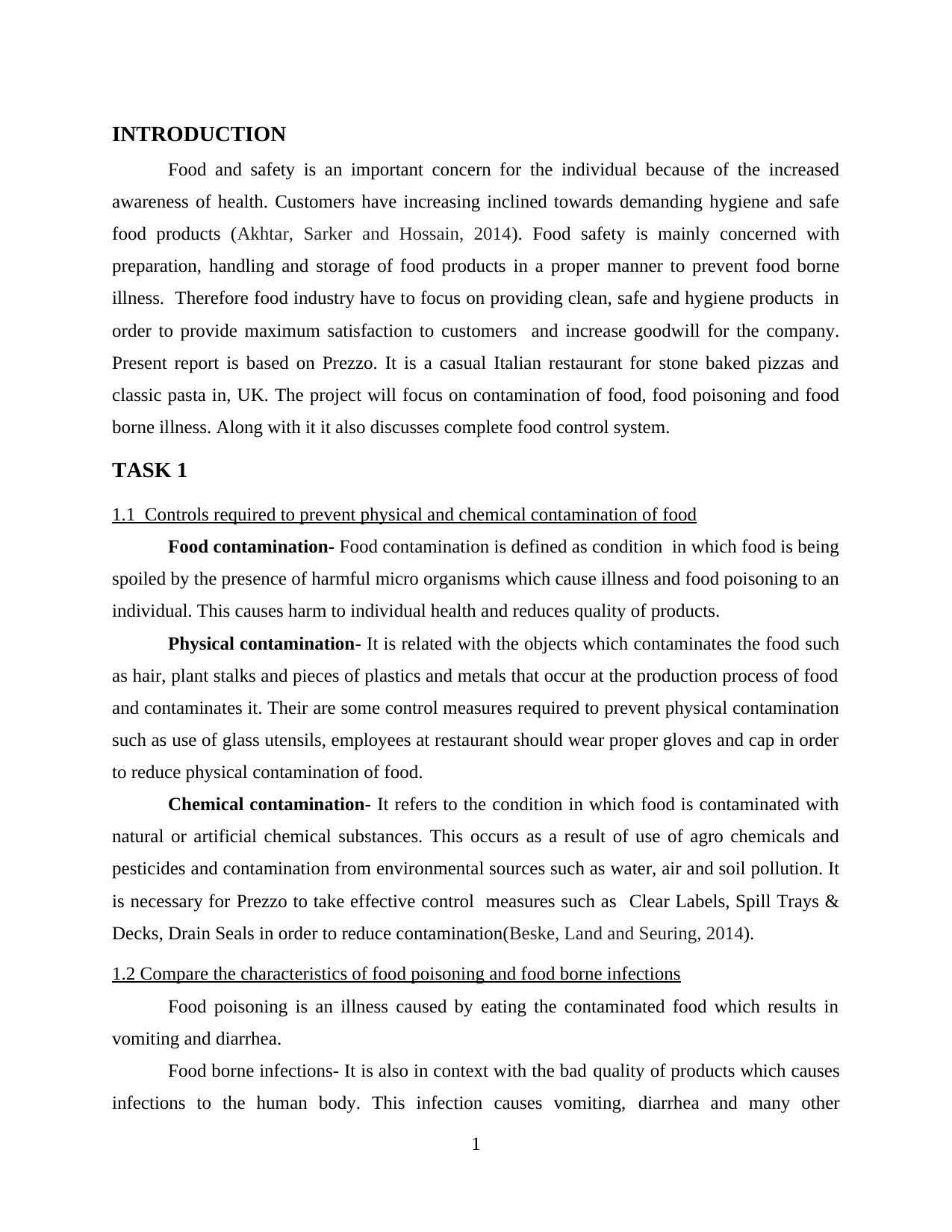
INTRODUCTION
Food and safety is an important concern for the individual because of the increased
awareness of health. Customers have increasing inclined towards demanding hygiene and safe
food products (Akhtar, Sarker and Hossain, 2014). Food safety is mainly concerned with
preparation, handling and storage of food products in a proper manner to prevent food borne
illness. Therefore food industry have to focus on providing clean, safe and hygiene products in
order to provide maximum satisfaction to customers and increase goodwill for the company.
Present report is based on Prezzo. It is a casual Italian restaurant for stone baked pizzas and
classic pasta in, UK. The project will focus on contamination of food, food poisoning and food
borne illness. Along with it it also discusses complete food control system.
TASK 1
1.1 Controls required to prevent physical and chemical contamination of food
Food contamination- Food contamination is defined as condition in which food is being
spoiled by the presence of harmful micro organisms which cause illness and food poisoning to an
individual. This causes harm to individual health and reduces quality of products.
Physical contamination- It is related with the objects which contaminates the food such
as hair, plant stalks and pieces of plastics and metals that occur at the production process of food
and contaminates it. Their are some control measures required to prevent physical contamination
such as use of glass utensils, employees at restaurant should wear proper gloves and cap in order
to reduce physical contamination of food.
Chemical contamination- It refers to the condition in which food is contaminated with
natural or artificial chemical substances. This occurs as a result of use of agro chemicals and
pesticides and contamination from environmental sources such as water, air and soil pollution. It
is necessary for Prezzo to take effective control measures such as Clear Labels, Spill Trays &
Decks, Drain Seals in order to reduce contamination(Beske, Land and Seuring, 2014).
1.2 Compare the characteristics of food poisoning and food borne infections
Food poisoning is an illness caused by eating the contaminated food which results in
vomiting and diarrhea.
Food borne infections- It is also in context with the bad quality of products which causes
infections to the human body. This infection causes vomiting, diarrhea and many other
1
Food and safety is an important concern for the individual because of the increased
awareness of health. Customers have increasing inclined towards demanding hygiene and safe
food products (Akhtar, Sarker and Hossain, 2014). Food safety is mainly concerned with
preparation, handling and storage of food products in a proper manner to prevent food borne
illness. Therefore food industry have to focus on providing clean, safe and hygiene products in
order to provide maximum satisfaction to customers and increase goodwill for the company.
Present report is based on Prezzo. It is a casual Italian restaurant for stone baked pizzas and
classic pasta in, UK. The project will focus on contamination of food, food poisoning and food
borne illness. Along with it it also discusses complete food control system.
TASK 1
1.1 Controls required to prevent physical and chemical contamination of food
Food contamination- Food contamination is defined as condition in which food is being
spoiled by the presence of harmful micro organisms which cause illness and food poisoning to an
individual. This causes harm to individual health and reduces quality of products.
Physical contamination- It is related with the objects which contaminates the food such
as hair, plant stalks and pieces of plastics and metals that occur at the production process of food
and contaminates it. Their are some control measures required to prevent physical contamination
such as use of glass utensils, employees at restaurant should wear proper gloves and cap in order
to reduce physical contamination of food.
Chemical contamination- It refers to the condition in which food is contaminated with
natural or artificial chemical substances. This occurs as a result of use of agro chemicals and
pesticides and contamination from environmental sources such as water, air and soil pollution. It
is necessary for Prezzo to take effective control measures such as Clear Labels, Spill Trays &
Decks, Drain Seals in order to reduce contamination(Beske, Land and Seuring, 2014).
1.2 Compare the characteristics of food poisoning and food borne infections
Food poisoning is an illness caused by eating the contaminated food which results in
vomiting and diarrhea.
Food borne infections- It is also in context with the bad quality of products which causes
infections to the human body. This infection causes vomiting, diarrhea and many other
1
Paraphrase This Document
Need a fresh take? Get an instant paraphrase of this document with our AI Paraphraser
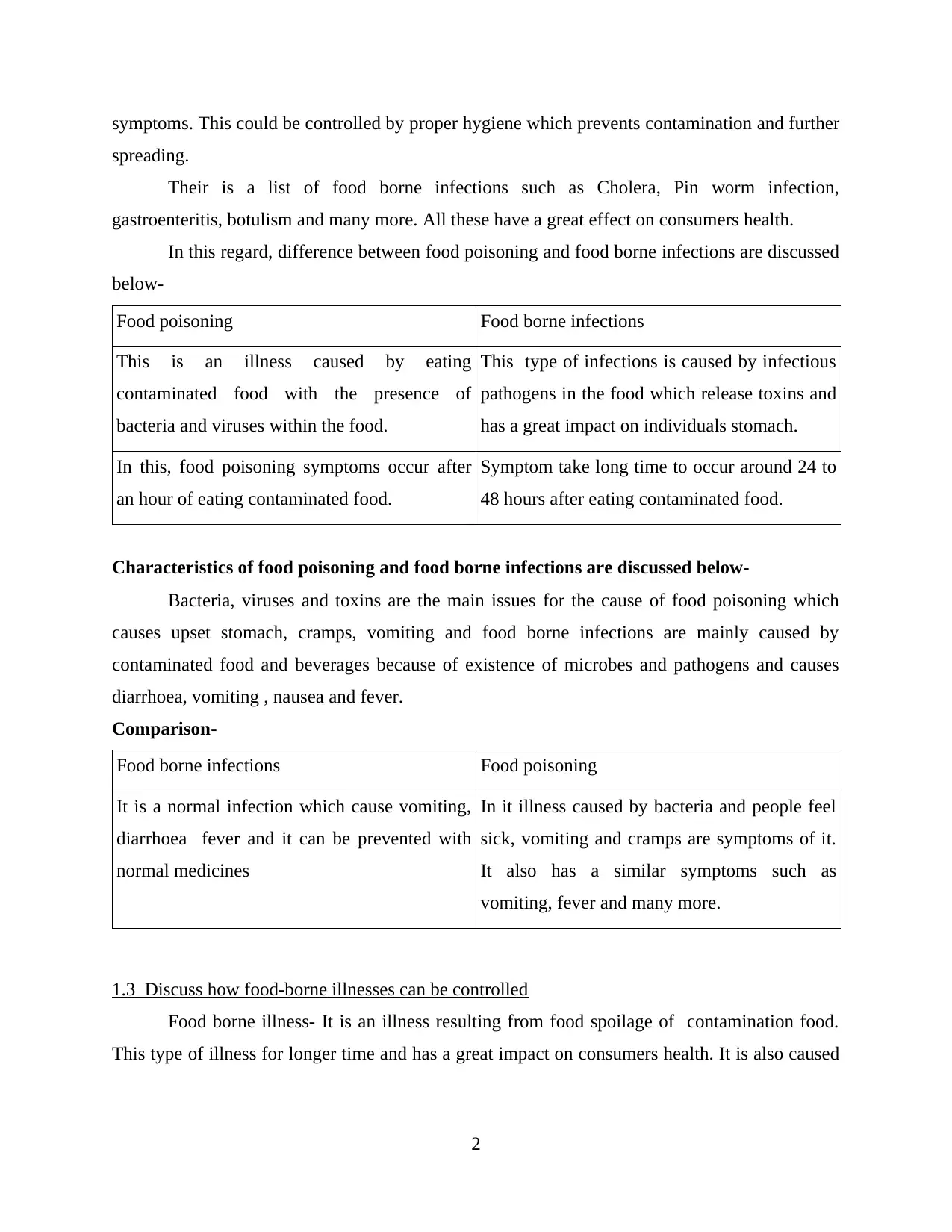
symptoms. This could be controlled by proper hygiene which prevents contamination and further
spreading.
Their is a list of food borne infections such as Cholera, Pin worm infection,
gastroenteritis, botulism and many more. All these have a great effect on consumers health.
In this regard, difference between food poisoning and food borne infections are discussed
below-
Food poisoning Food borne infections
This is an illness caused by eating
contaminated food with the presence of
bacteria and viruses within the food.
This type of infections is caused by infectious
pathogens in the food which release toxins and
has a great impact on individuals stomach.
In this, food poisoning symptoms occur after
an hour of eating contaminated food.
Symptom take long time to occur around 24 to
48 hours after eating contaminated food.
Characteristics of food poisoning and food borne infections are discussed below-
Bacteria, viruses and toxins are the main issues for the cause of food poisoning which
causes upset stomach, cramps, vomiting and food borne infections are mainly caused by
contaminated food and beverages because of existence of microbes and pathogens and causes
diarrhoea, vomiting , nausea and fever.
Comparison-
Food borne infections Food poisoning
It is a normal infection which cause vomiting,
diarrhoea fever and it can be prevented with
normal medicines
In it illness caused by bacteria and people feel
sick, vomiting and cramps are symptoms of it.
It also has a similar symptoms such as
vomiting, fever and many more.
1.3 Discuss how food-borne illnesses can be controlled
Food borne illness- It is an illness resulting from food spoilage of contamination food.
This type of illness for longer time and has a great impact on consumers health. It is also caused
2
spreading.
Their is a list of food borne infections such as Cholera, Pin worm infection,
gastroenteritis, botulism and many more. All these have a great effect on consumers health.
In this regard, difference between food poisoning and food borne infections are discussed
below-
Food poisoning Food borne infections
This is an illness caused by eating
contaminated food with the presence of
bacteria and viruses within the food.
This type of infections is caused by infectious
pathogens in the food which release toxins and
has a great impact on individuals stomach.
In this, food poisoning symptoms occur after
an hour of eating contaminated food.
Symptom take long time to occur around 24 to
48 hours after eating contaminated food.
Characteristics of food poisoning and food borne infections are discussed below-
Bacteria, viruses and toxins are the main issues for the cause of food poisoning which
causes upset stomach, cramps, vomiting and food borne infections are mainly caused by
contaminated food and beverages because of existence of microbes and pathogens and causes
diarrhoea, vomiting , nausea and fever.
Comparison-
Food borne infections Food poisoning
It is a normal infection which cause vomiting,
diarrhoea fever and it can be prevented with
normal medicines
In it illness caused by bacteria and people feel
sick, vomiting and cramps are symptoms of it.
It also has a similar symptoms such as
vomiting, fever and many more.
1.3 Discuss how food-borne illnesses can be controlled
Food borne illness- It is an illness resulting from food spoilage of contamination food.
This type of illness for longer time and has a great impact on consumers health. It is also caused
2
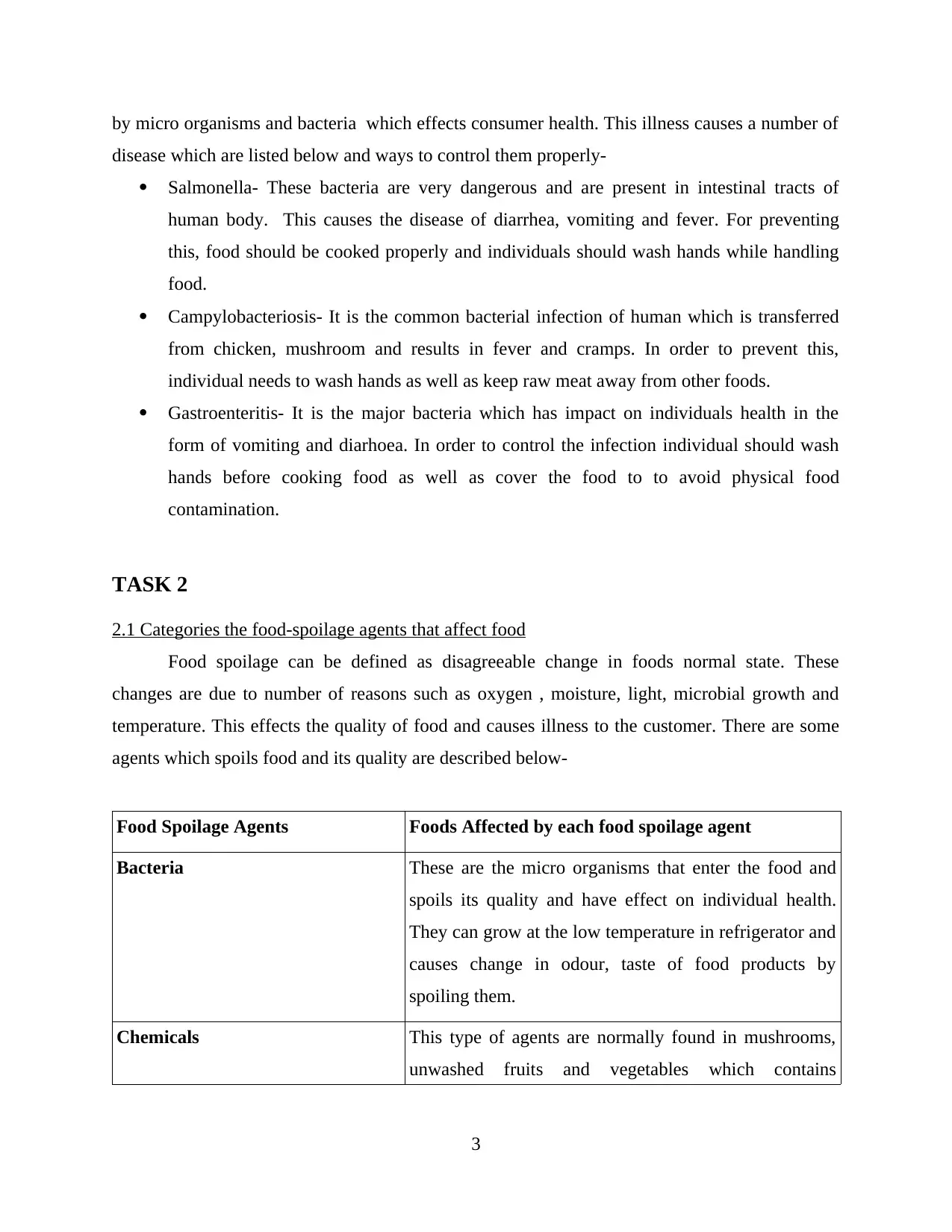
by micro organisms and bacteria which effects consumer health. This illness causes a number of
disease which are listed below and ways to control them properly-
Salmonella- These bacteria are very dangerous and are present in intestinal tracts of
human body. This causes the disease of diarrhea, vomiting and fever. For preventing
this, food should be cooked properly and individuals should wash hands while handling
food.
Campylobacteriosis- It is the common bacterial infection of human which is transferred
from chicken, mushroom and results in fever and cramps. In order to prevent this,
individual needs to wash hands as well as keep raw meat away from other foods.
Gastroenteritis- It is the major bacteria which has impact on individuals health in the
form of vomiting and diarhoea. In order to control the infection individual should wash
hands before cooking food as well as cover the food to to avoid physical food
contamination.
TASK 2
2.1 Categories the food-spoilage agents that affect food
Food spoilage can be defined as disagreeable change in foods normal state. These
changes are due to number of reasons such as oxygen , moisture, light, microbial growth and
temperature. This effects the quality of food and causes illness to the customer. There are some
agents which spoils food and its quality are described below-
Food Spoilage Agents Foods Affected by each food spoilage agent
Bacteria These are the micro organisms that enter the food and
spoils its quality and have effect on individual health.
They can grow at the low temperature in refrigerator and
causes change in odour, taste of food products by
spoiling them.
Chemicals This type of agents are normally found in mushrooms,
unwashed fruits and vegetables which contains
3
disease which are listed below and ways to control them properly-
Salmonella- These bacteria are very dangerous and are present in intestinal tracts of
human body. This causes the disease of diarrhea, vomiting and fever. For preventing
this, food should be cooked properly and individuals should wash hands while handling
food.
Campylobacteriosis- It is the common bacterial infection of human which is transferred
from chicken, mushroom and results in fever and cramps. In order to prevent this,
individual needs to wash hands as well as keep raw meat away from other foods.
Gastroenteritis- It is the major bacteria which has impact on individuals health in the
form of vomiting and diarhoea. In order to control the infection individual should wash
hands before cooking food as well as cover the food to to avoid physical food
contamination.
TASK 2
2.1 Categories the food-spoilage agents that affect food
Food spoilage can be defined as disagreeable change in foods normal state. These
changes are due to number of reasons such as oxygen , moisture, light, microbial growth and
temperature. This effects the quality of food and causes illness to the customer. There are some
agents which spoils food and its quality are described below-
Food Spoilage Agents Foods Affected by each food spoilage agent
Bacteria These are the micro organisms that enter the food and
spoils its quality and have effect on individual health.
They can grow at the low temperature in refrigerator and
causes change in odour, taste of food products by
spoiling them.
Chemicals This type of agents are normally found in mushrooms,
unwashed fruits and vegetables which contains
3
⊘ This is a preview!⊘
Do you want full access?
Subscribe today to unlock all pages.

Trusted by 1+ million students worldwide
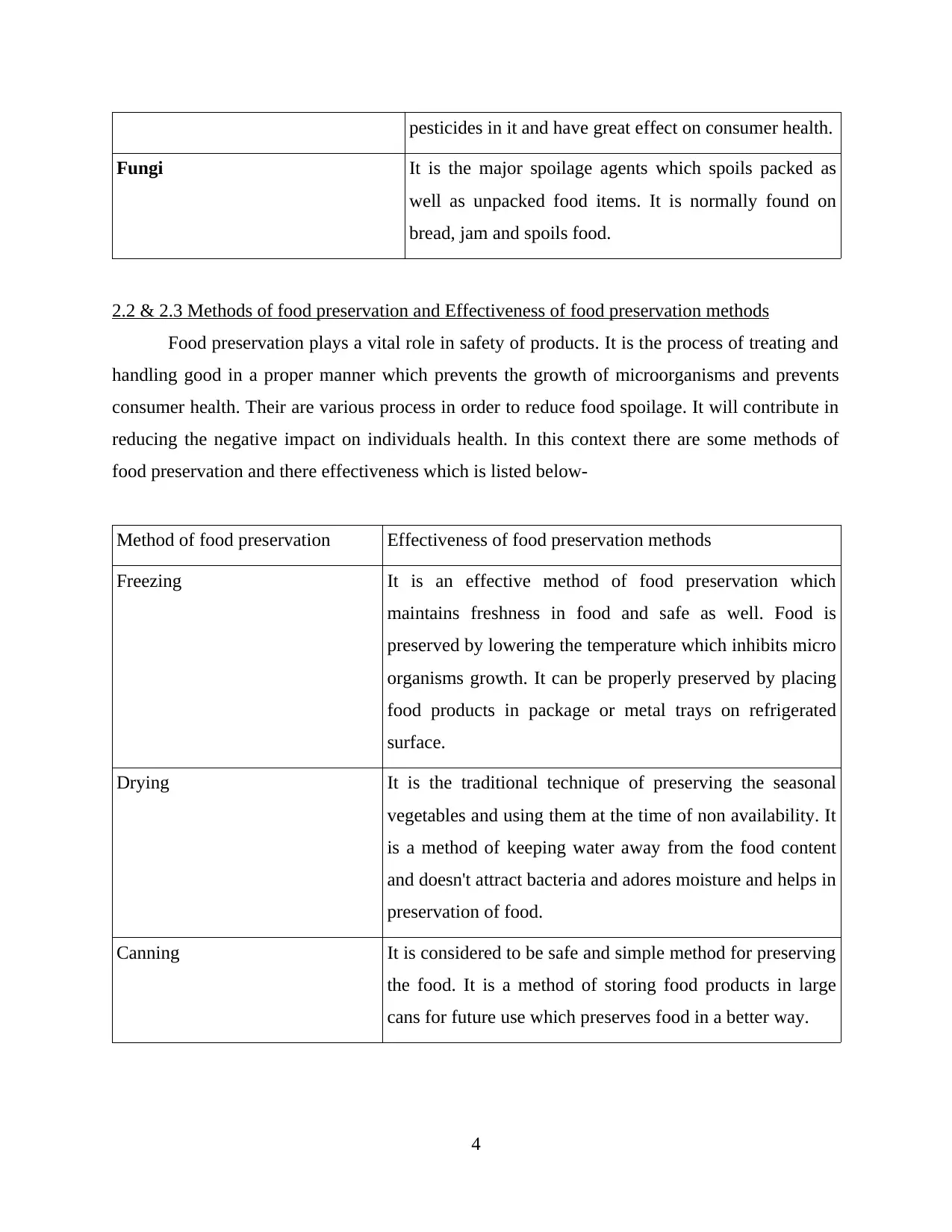
pesticides in it and have great effect on consumer health.
Fungi It is the major spoilage agents which spoils packed as
well as unpacked food items. It is normally found on
bread, jam and spoils food.
2.2 & 2.3 Methods of food preservation and Effectiveness of food preservation methods
Food preservation plays a vital role in safety of products. It is the process of treating and
handling good in a proper manner which prevents the growth of microorganisms and prevents
consumer health. Their are various process in order to reduce food spoilage. It will contribute in
reducing the negative impact on individuals health. In this context there are some methods of
food preservation and there effectiveness which is listed below-
Method of food preservation Effectiveness of food preservation methods
Freezing It is an effective method of food preservation which
maintains freshness in food and safe as well. Food is
preserved by lowering the temperature which inhibits micro
organisms growth. It can be properly preserved by placing
food products in package or metal trays on refrigerated
surface.
Drying It is the traditional technique of preserving the seasonal
vegetables and using them at the time of non availability. It
is a method of keeping water away from the food content
and doesn't attract bacteria and adores moisture and helps in
preservation of food.
Canning It is considered to be safe and simple method for preserving
the food. It is a method of storing food products in large
cans for future use which preserves food in a better way.
4
Fungi It is the major spoilage agents which spoils packed as
well as unpacked food items. It is normally found on
bread, jam and spoils food.
2.2 & 2.3 Methods of food preservation and Effectiveness of food preservation methods
Food preservation plays a vital role in safety of products. It is the process of treating and
handling good in a proper manner which prevents the growth of microorganisms and prevents
consumer health. Their are various process in order to reduce food spoilage. It will contribute in
reducing the negative impact on individuals health. In this context there are some methods of
food preservation and there effectiveness which is listed below-
Method of food preservation Effectiveness of food preservation methods
Freezing It is an effective method of food preservation which
maintains freshness in food and safe as well. Food is
preserved by lowering the temperature which inhibits micro
organisms growth. It can be properly preserved by placing
food products in package or metal trays on refrigerated
surface.
Drying It is the traditional technique of preserving the seasonal
vegetables and using them at the time of non availability. It
is a method of keeping water away from the food content
and doesn't attract bacteria and adores moisture and helps in
preservation of food.
Canning It is considered to be safe and simple method for preserving
the food. It is a method of storing food products in large
cans for future use which preserves food in a better way.
4
Paraphrase This Document
Need a fresh take? Get an instant paraphrase of this document with our AI Paraphraser
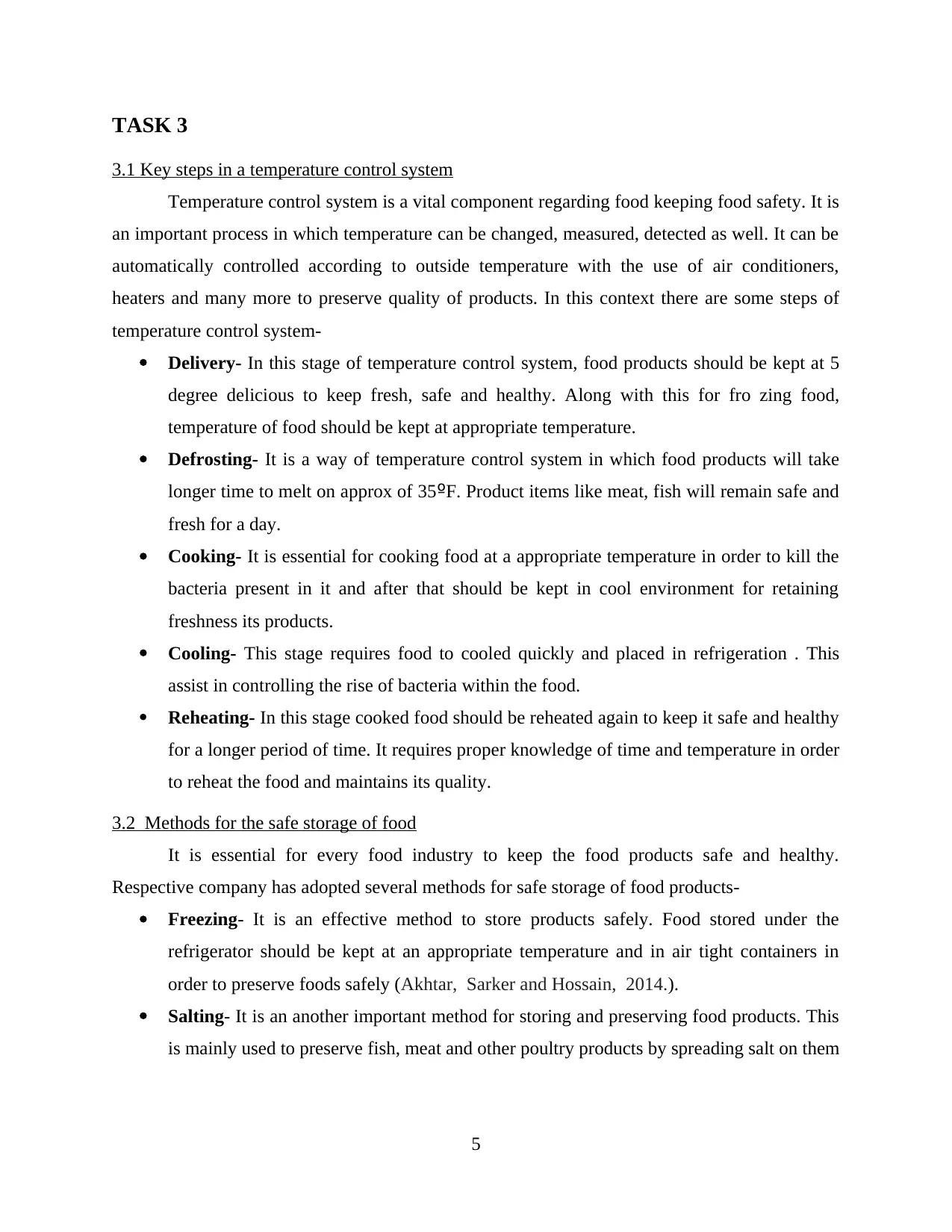
TASK 3
3.1 Key steps in a temperature control system
Temperature control system is a vital component regarding food keeping food safety. It is
an important process in which temperature can be changed, measured, detected as well. It can be
automatically controlled according to outside temperature with the use of air conditioners,
heaters and many more to preserve quality of products. In this context there are some steps of
temperature control system-
Delivery- In this stage of temperature control system, food products should be kept at 5
degree delicious to keep fresh, safe and healthy. Along with this for fro zing food,
temperature of food should be kept at appropriate temperature.
Defrosting- It is a way of temperature control system in which food products will take
longer time to melt on approx of 35ºF. Product items like meat, fish will remain safe and
fresh for a day.
Cooking- It is essential for cooking food at a appropriate temperature in order to kill the
bacteria present in it and after that should be kept in cool environment for retaining
freshness its products.
Cooling- This stage requires food to cooled quickly and placed in refrigeration . This
assist in controlling the rise of bacteria within the food.
Reheating- In this stage cooked food should be reheated again to keep it safe and healthy
for a longer period of time. It requires proper knowledge of time and temperature in order
to reheat the food and maintains its quality.
3.2 Methods for the safe storage of food
It is essential for every food industry to keep the food products safe and healthy.
Respective company has adopted several methods for safe storage of food products-
Freezing- It is an effective method to store products safely. Food stored under the
refrigerator should be kept at an appropriate temperature and in air tight containers in
order to preserve foods safely (Akhtar, Sarker and Hossain, 2014.).
Salting- It is an another important method for storing and preserving food products. This
is mainly used to preserve fish, meat and other poultry products by spreading salt on them
5
3.1 Key steps in a temperature control system
Temperature control system is a vital component regarding food keeping food safety. It is
an important process in which temperature can be changed, measured, detected as well. It can be
automatically controlled according to outside temperature with the use of air conditioners,
heaters and many more to preserve quality of products. In this context there are some steps of
temperature control system-
Delivery- In this stage of temperature control system, food products should be kept at 5
degree delicious to keep fresh, safe and healthy. Along with this for fro zing food,
temperature of food should be kept at appropriate temperature.
Defrosting- It is a way of temperature control system in which food products will take
longer time to melt on approx of 35ºF. Product items like meat, fish will remain safe and
fresh for a day.
Cooking- It is essential for cooking food at a appropriate temperature in order to kill the
bacteria present in it and after that should be kept in cool environment for retaining
freshness its products.
Cooling- This stage requires food to cooled quickly and placed in refrigeration . This
assist in controlling the rise of bacteria within the food.
Reheating- In this stage cooked food should be reheated again to keep it safe and healthy
for a longer period of time. It requires proper knowledge of time and temperature in order
to reheat the food and maintains its quality.
3.2 Methods for the safe storage of food
It is essential for every food industry to keep the food products safe and healthy.
Respective company has adopted several methods for safe storage of food products-
Freezing- It is an effective method to store products safely. Food stored under the
refrigerator should be kept at an appropriate temperature and in air tight containers in
order to preserve foods safely (Akhtar, Sarker and Hossain, 2014.).
Salting- It is an another important method for storing and preserving food products. This
is mainly used to preserve fish, meat and other poultry products by spreading salt on them
5
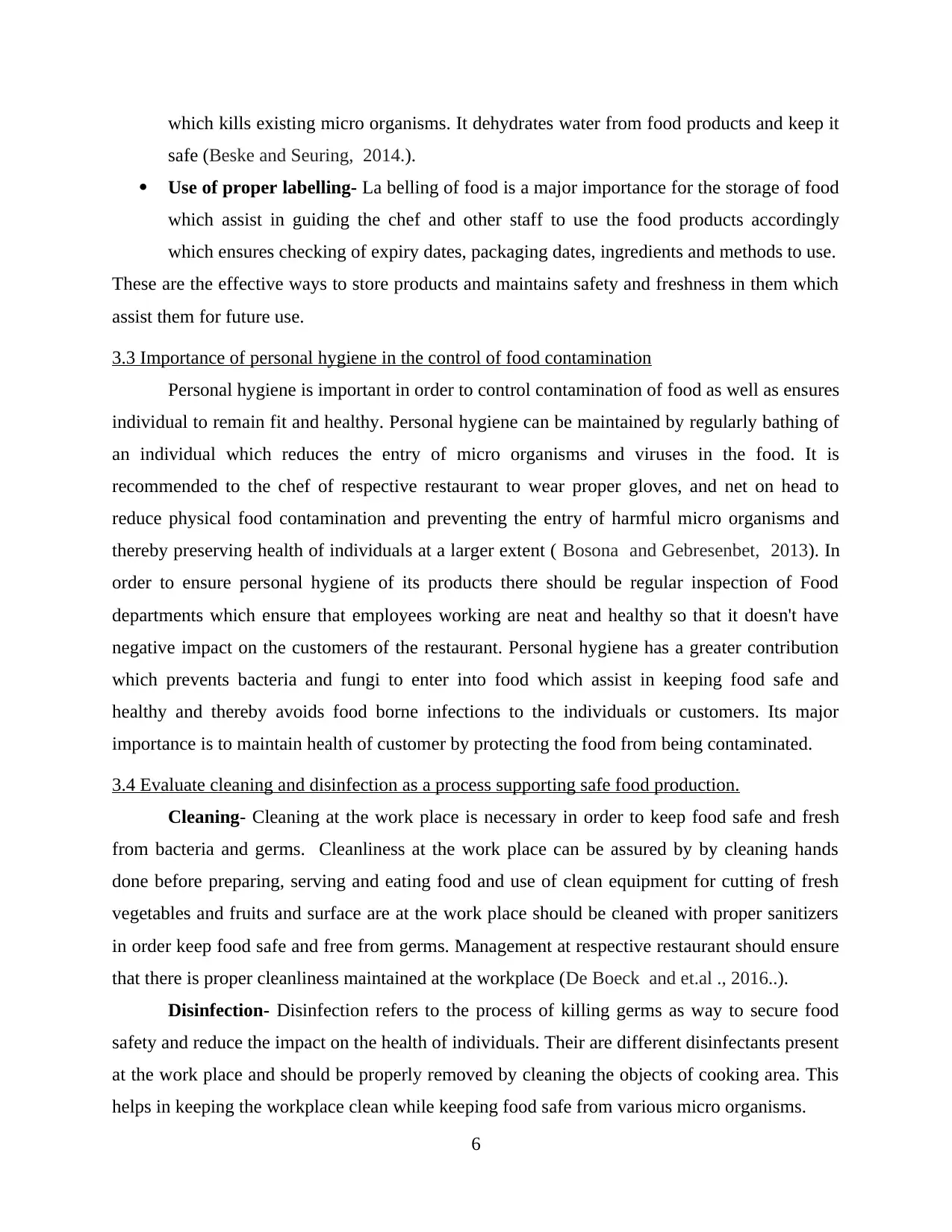
which kills existing micro organisms. It dehydrates water from food products and keep it
safe (Beske and Seuring, 2014.).
Use of proper labelling- La belling of food is a major importance for the storage of food
which assist in guiding the chef and other staff to use the food products accordingly
which ensures checking of expiry dates, packaging dates, ingredients and methods to use.
These are the effective ways to store products and maintains safety and freshness in them which
assist them for future use.
3.3 Importance of personal hygiene in the control of food contamination
Personal hygiene is important in order to control contamination of food as well as ensures
individual to remain fit and healthy. Personal hygiene can be maintained by regularly bathing of
an individual which reduces the entry of micro organisms and viruses in the food. It is
recommended to the chef of respective restaurant to wear proper gloves, and net on head to
reduce physical food contamination and preventing the entry of harmful micro organisms and
thereby preserving health of individuals at a larger extent ( Bosona and Gebresenbet, 2013). In
order to ensure personal hygiene of its products there should be regular inspection of Food
departments which ensure that employees working are neat and healthy so that it doesn't have
negative impact on the customers of the restaurant. Personal hygiene has a greater contribution
which prevents bacteria and fungi to enter into food which assist in keeping food safe and
healthy and thereby avoids food borne infections to the individuals or customers. Its major
importance is to maintain health of customer by protecting the food from being contaminated.
3.4 Evaluate cleaning and disinfection as a process supporting safe food production.
Cleaning- Cleaning at the work place is necessary in order to keep food safe and fresh
from bacteria and germs. Cleanliness at the work place can be assured by by cleaning hands
done before preparing, serving and eating food and use of clean equipment for cutting of fresh
vegetables and fruits and surface are at the work place should be cleaned with proper sanitizers
in order keep food safe and free from germs. Management at respective restaurant should ensure
that there is proper cleanliness maintained at the workplace (De Boeck and et.al ., 2016..).
Disinfection- Disinfection refers to the process of killing germs as way to secure food
safety and reduce the impact on the health of individuals. Their are different disinfectants present
at the work place and should be properly removed by cleaning the objects of cooking area. This
helps in keeping the workplace clean while keeping food safe from various micro organisms.
6
safe (Beske and Seuring, 2014.).
Use of proper labelling- La belling of food is a major importance for the storage of food
which assist in guiding the chef and other staff to use the food products accordingly
which ensures checking of expiry dates, packaging dates, ingredients and methods to use.
These are the effective ways to store products and maintains safety and freshness in them which
assist them for future use.
3.3 Importance of personal hygiene in the control of food contamination
Personal hygiene is important in order to control contamination of food as well as ensures
individual to remain fit and healthy. Personal hygiene can be maintained by regularly bathing of
an individual which reduces the entry of micro organisms and viruses in the food. It is
recommended to the chef of respective restaurant to wear proper gloves, and net on head to
reduce physical food contamination and preventing the entry of harmful micro organisms and
thereby preserving health of individuals at a larger extent ( Bosona and Gebresenbet, 2013). In
order to ensure personal hygiene of its products there should be regular inspection of Food
departments which ensure that employees working are neat and healthy so that it doesn't have
negative impact on the customers of the restaurant. Personal hygiene has a greater contribution
which prevents bacteria and fungi to enter into food which assist in keeping food safe and
healthy and thereby avoids food borne infections to the individuals or customers. Its major
importance is to maintain health of customer by protecting the food from being contaminated.
3.4 Evaluate cleaning and disinfection as a process supporting safe food production.
Cleaning- Cleaning at the work place is necessary in order to keep food safe and fresh
from bacteria and germs. Cleanliness at the work place can be assured by by cleaning hands
done before preparing, serving and eating food and use of clean equipment for cutting of fresh
vegetables and fruits and surface are at the work place should be cleaned with proper sanitizers
in order keep food safe and free from germs. Management at respective restaurant should ensure
that there is proper cleanliness maintained at the workplace (De Boeck and et.al ., 2016..).
Disinfection- Disinfection refers to the process of killing germs as way to secure food
safety and reduce the impact on the health of individuals. Their are different disinfectants present
at the work place and should be properly removed by cleaning the objects of cooking area. This
helps in keeping the workplace clean while keeping food safe from various micro organisms.
6
⊘ This is a preview!⊘
Do you want full access?
Subscribe today to unlock all pages.

Trusted by 1+ million students worldwide
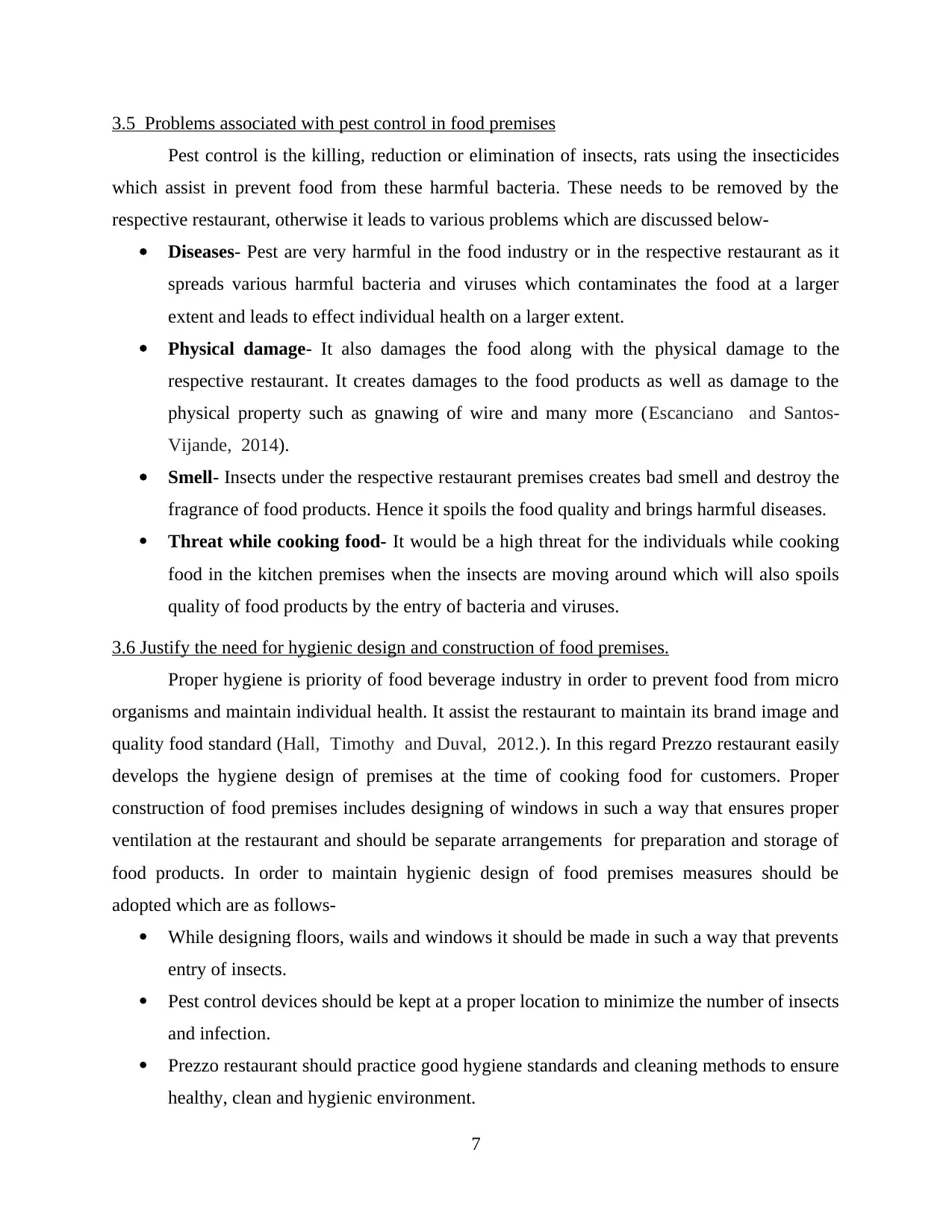
3.5 Problems associated with pest control in food premises
Pest control is the killing, reduction or elimination of insects, rats using the insecticides
which assist in prevent food from these harmful bacteria. These needs to be removed by the
respective restaurant, otherwise it leads to various problems which are discussed below-
Diseases- Pest are very harmful in the food industry or in the respective restaurant as it
spreads various harmful bacteria and viruses which contaminates the food at a larger
extent and leads to effect individual health on a larger extent.
Physical damage- It also damages the food along with the physical damage to the
respective restaurant. It creates damages to the food products as well as damage to the
physical property such as gnawing of wire and many more (Escanciano and Santos-
Vijande, 2014).
Smell- Insects under the respective restaurant premises creates bad smell and destroy the
fragrance of food products. Hence it spoils the food quality and brings harmful diseases.
Threat while cooking food- It would be a high threat for the individuals while cooking
food in the kitchen premises when the insects are moving around which will also spoils
quality of food products by the entry of bacteria and viruses.
3.6 Justify the need for hygienic design and construction of food premises.
Proper hygiene is priority of food beverage industry in order to prevent food from micro
organisms and maintain individual health. It assist the restaurant to maintain its brand image and
quality food standard (Hall, Timothy and Duval, 2012.). In this regard Prezzo restaurant easily
develops the hygiene design of premises at the time of cooking food for customers. Proper
construction of food premises includes designing of windows in such a way that ensures proper
ventilation at the restaurant and should be separate arrangements for preparation and storage of
food products. In order to maintain hygienic design of food premises measures should be
adopted which are as follows-
While designing floors, wails and windows it should be made in such a way that prevents
entry of insects.
Pest control devices should be kept at a proper location to minimize the number of insects
and infection.
Prezzo restaurant should practice good hygiene standards and cleaning methods to ensure
healthy, clean and hygienic environment.
7
Pest control is the killing, reduction or elimination of insects, rats using the insecticides
which assist in prevent food from these harmful bacteria. These needs to be removed by the
respective restaurant, otherwise it leads to various problems which are discussed below-
Diseases- Pest are very harmful in the food industry or in the respective restaurant as it
spreads various harmful bacteria and viruses which contaminates the food at a larger
extent and leads to effect individual health on a larger extent.
Physical damage- It also damages the food along with the physical damage to the
respective restaurant. It creates damages to the food products as well as damage to the
physical property such as gnawing of wire and many more (Escanciano and Santos-
Vijande, 2014).
Smell- Insects under the respective restaurant premises creates bad smell and destroy the
fragrance of food products. Hence it spoils the food quality and brings harmful diseases.
Threat while cooking food- It would be a high threat for the individuals while cooking
food in the kitchen premises when the insects are moving around which will also spoils
quality of food products by the entry of bacteria and viruses.
3.6 Justify the need for hygienic design and construction of food premises.
Proper hygiene is priority of food beverage industry in order to prevent food from micro
organisms and maintain individual health. It assist the restaurant to maintain its brand image and
quality food standard (Hall, Timothy and Duval, 2012.). In this regard Prezzo restaurant easily
develops the hygiene design of premises at the time of cooking food for customers. Proper
construction of food premises includes designing of windows in such a way that ensures proper
ventilation at the restaurant and should be separate arrangements for preparation and storage of
food products. In order to maintain hygienic design of food premises measures should be
adopted which are as follows-
While designing floors, wails and windows it should be made in such a way that prevents
entry of insects.
Pest control devices should be kept at a proper location to minimize the number of insects
and infection.
Prezzo restaurant should practice good hygiene standards and cleaning methods to ensure
healthy, clean and hygienic environment.
7
Paraphrase This Document
Need a fresh take? Get an instant paraphrase of this document with our AI Paraphraser
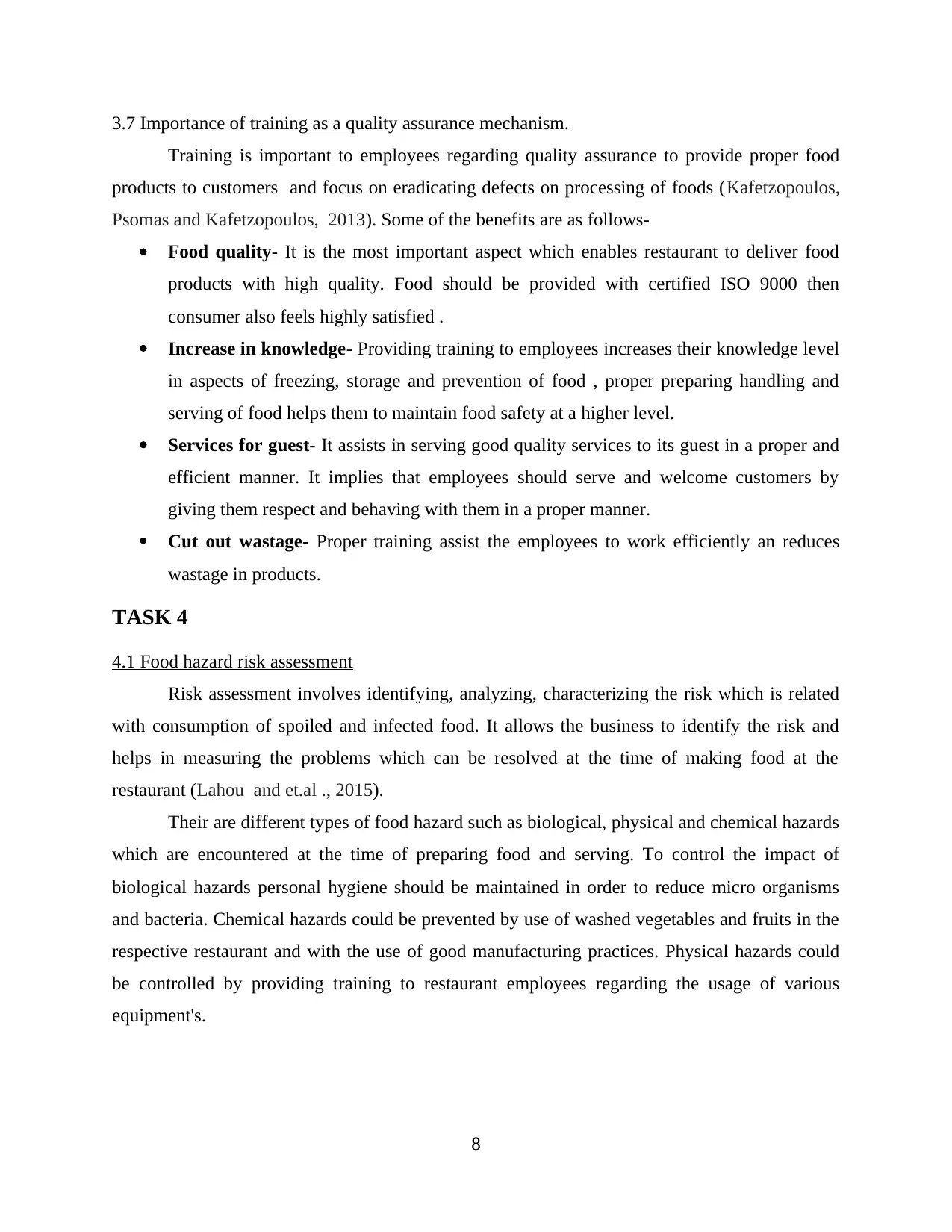
3.7 Importance of training as a quality assurance mechanism.
Training is important to employees regarding quality assurance to provide proper food
products to customers and focus on eradicating defects on processing of foods (Kafetzopoulos,
Psomas and Kafetzopoulos, 2013). Some of the benefits are as follows-
Food quality- It is the most important aspect which enables restaurant to deliver food
products with high quality. Food should be provided with certified ISO 9000 then
consumer also feels highly satisfied .
Increase in knowledge- Providing training to employees increases their knowledge level
in aspects of freezing, storage and prevention of food , proper preparing handling and
serving of food helps them to maintain food safety at a higher level.
Services for guest- It assists in serving good quality services to its guest in a proper and
efficient manner. It implies that employees should serve and welcome customers by
giving them respect and behaving with them in a proper manner.
Cut out wastage- Proper training assist the employees to work efficiently an reduces
wastage in products.
TASK 4
4.1 Food hazard risk assessment
Risk assessment involves identifying, analyzing, characterizing the risk which is related
with consumption of spoiled and infected food. It allows the business to identify the risk and
helps in measuring the problems which can be resolved at the time of making food at the
restaurant (Lahou and et.al ., 2015).
Their are different types of food hazard such as biological, physical and chemical hazards
which are encountered at the time of preparing food and serving. To control the impact of
biological hazards personal hygiene should be maintained in order to reduce micro organisms
and bacteria. Chemical hazards could be prevented by use of washed vegetables and fruits in the
respective restaurant and with the use of good manufacturing practices. Physical hazards could
be controlled by providing training to restaurant employees regarding the usage of various
equipment's.
8
Training is important to employees regarding quality assurance to provide proper food
products to customers and focus on eradicating defects on processing of foods (Kafetzopoulos,
Psomas and Kafetzopoulos, 2013). Some of the benefits are as follows-
Food quality- It is the most important aspect which enables restaurant to deliver food
products with high quality. Food should be provided with certified ISO 9000 then
consumer also feels highly satisfied .
Increase in knowledge- Providing training to employees increases their knowledge level
in aspects of freezing, storage and prevention of food , proper preparing handling and
serving of food helps them to maintain food safety at a higher level.
Services for guest- It assists in serving good quality services to its guest in a proper and
efficient manner. It implies that employees should serve and welcome customers by
giving them respect and behaving with them in a proper manner.
Cut out wastage- Proper training assist the employees to work efficiently an reduces
wastage in products.
TASK 4
4.1 Food hazard risk assessment
Risk assessment involves identifying, analyzing, characterizing the risk which is related
with consumption of spoiled and infected food. It allows the business to identify the risk and
helps in measuring the problems which can be resolved at the time of making food at the
restaurant (Lahou and et.al ., 2015).
Their are different types of food hazard such as biological, physical and chemical hazards
which are encountered at the time of preparing food and serving. To control the impact of
biological hazards personal hygiene should be maintained in order to reduce micro organisms
and bacteria. Chemical hazards could be prevented by use of washed vegetables and fruits in the
respective restaurant and with the use of good manufacturing practices. Physical hazards could
be controlled by providing training to restaurant employees regarding the usage of various
equipment's.
8
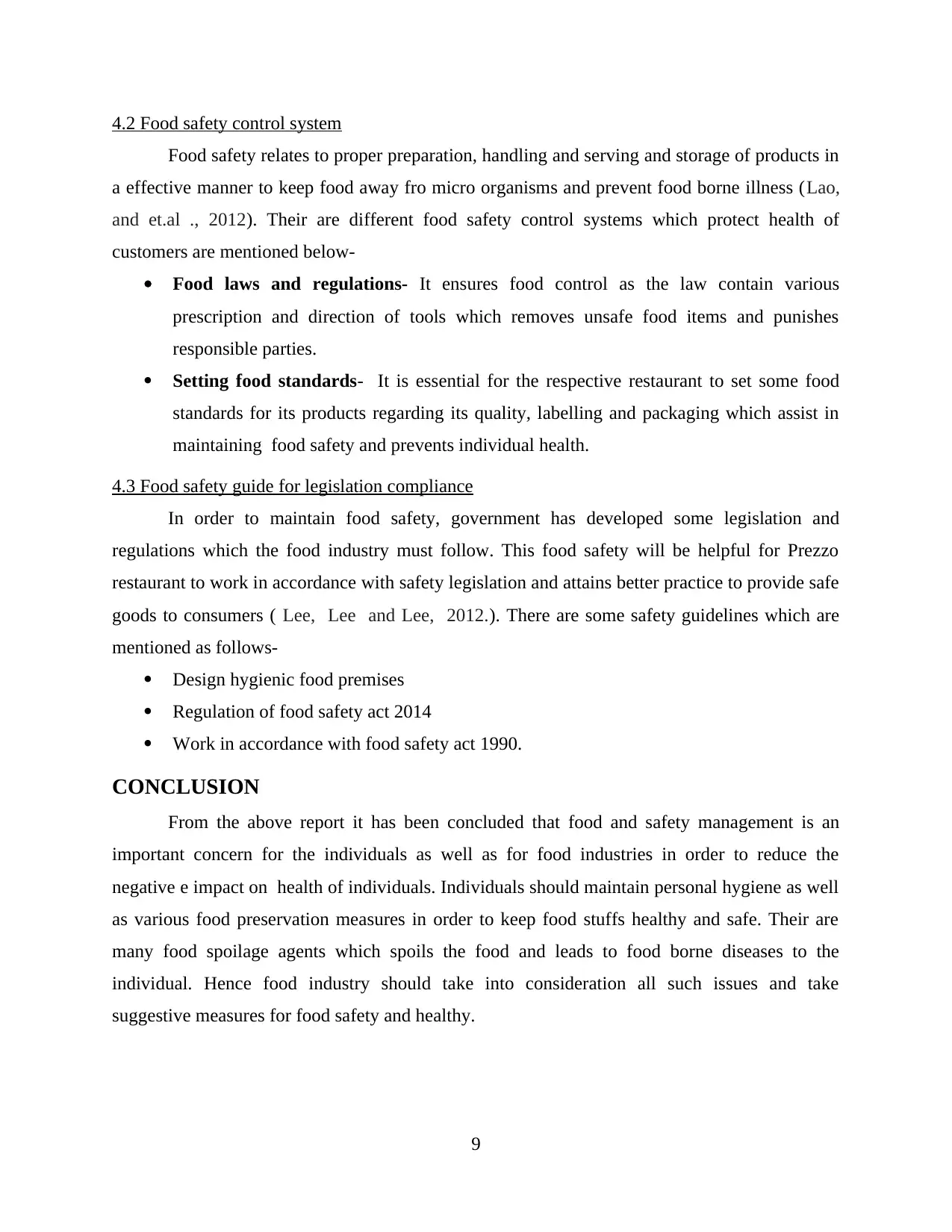
4.2 Food safety control system
Food safety relates to proper preparation, handling and serving and storage of products in
a effective manner to keep food away fro micro organisms and prevent food borne illness (Lao,
and et.al ., 2012). Their are different food safety control systems which protect health of
customers are mentioned below-
Food laws and regulations- It ensures food control as the law contain various
prescription and direction of tools which removes unsafe food items and punishes
responsible parties.
Setting food standards- It is essential for the respective restaurant to set some food
standards for its products regarding its quality, labelling and packaging which assist in
maintaining food safety and prevents individual health.
4.3 Food safety guide for legislation compliance
In order to maintain food safety, government has developed some legislation and
regulations which the food industry must follow. This food safety will be helpful for Prezzo
restaurant to work in accordance with safety legislation and attains better practice to provide safe
goods to consumers ( Lee, Lee and Lee, 2012.). There are some safety guidelines which are
mentioned as follows-
Design hygienic food premises
Regulation of food safety act 2014
Work in accordance with food safety act 1990.
CONCLUSION
From the above report it has been concluded that food and safety management is an
important concern for the individuals as well as for food industries in order to reduce the
negative e impact on health of individuals. Individuals should maintain personal hygiene as well
as various food preservation measures in order to keep food stuffs healthy and safe. Their are
many food spoilage agents which spoils the food and leads to food borne diseases to the
individual. Hence food industry should take into consideration all such issues and take
suggestive measures for food safety and healthy.
9
Food safety relates to proper preparation, handling and serving and storage of products in
a effective manner to keep food away fro micro organisms and prevent food borne illness (Lao,
and et.al ., 2012). Their are different food safety control systems which protect health of
customers are mentioned below-
Food laws and regulations- It ensures food control as the law contain various
prescription and direction of tools which removes unsafe food items and punishes
responsible parties.
Setting food standards- It is essential for the respective restaurant to set some food
standards for its products regarding its quality, labelling and packaging which assist in
maintaining food safety and prevents individual health.
4.3 Food safety guide for legislation compliance
In order to maintain food safety, government has developed some legislation and
regulations which the food industry must follow. This food safety will be helpful for Prezzo
restaurant to work in accordance with safety legislation and attains better practice to provide safe
goods to consumers ( Lee, Lee and Lee, 2012.). There are some safety guidelines which are
mentioned as follows-
Design hygienic food premises
Regulation of food safety act 2014
Work in accordance with food safety act 1990.
CONCLUSION
From the above report it has been concluded that food and safety management is an
important concern for the individuals as well as for food industries in order to reduce the
negative e impact on health of individuals. Individuals should maintain personal hygiene as well
as various food preservation measures in order to keep food stuffs healthy and safe. Their are
many food spoilage agents which spoils the food and leads to food borne diseases to the
individual. Hence food industry should take into consideration all such issues and take
suggestive measures for food safety and healthy.
9
⊘ This is a preview!⊘
Do you want full access?
Subscribe today to unlock all pages.

Trusted by 1+ million students worldwide
1 out of 13
Related Documents
Your All-in-One AI-Powered Toolkit for Academic Success.
+13062052269
info@desklib.com
Available 24*7 on WhatsApp / Email
![[object Object]](/_next/static/media/star-bottom.7253800d.svg)
Unlock your academic potential
Copyright © 2020–2025 A2Z Services. All Rights Reserved. Developed and managed by ZUCOL.





